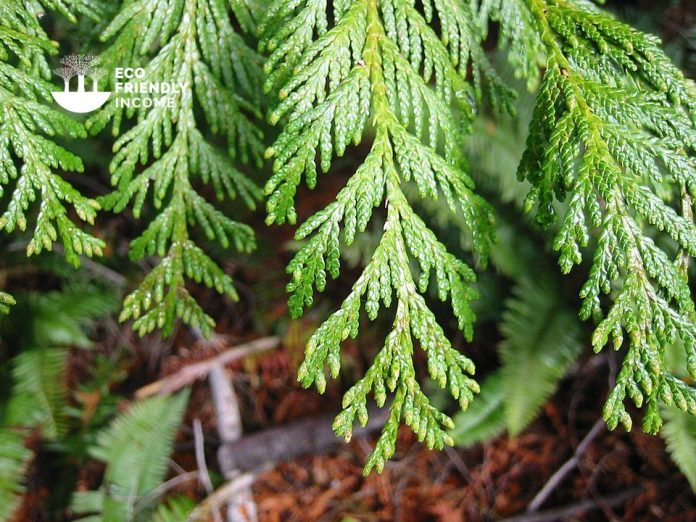
Featured Photo by Walter Siegmund / CC BY 2.5
A field guide on how to identify and propagate Western Red Cedar (Thuja plicata), a hardy tree that is native to eastern North America.
How to Identify Western Red Cedar (Thuja plicata)
Leaves
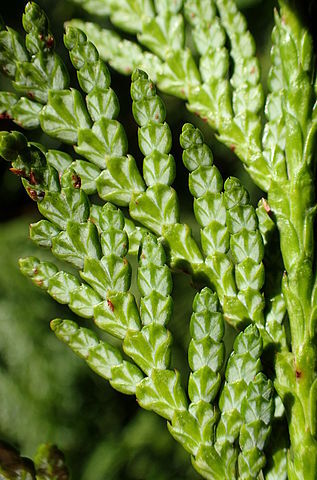
Western red cedar leaves are linear-shaped with entire margins (smooth) and grow on the stems in alternate arrangements.
The small, scale-like leaves grow on top of one another and give off a strong fragrance.
Bark
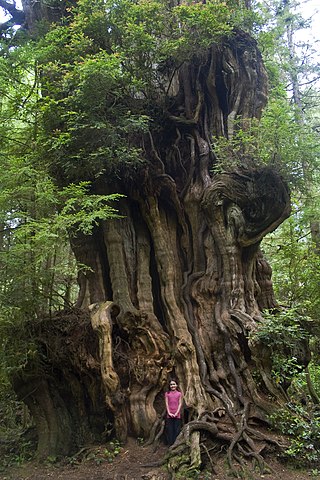
The outer bark of the Western Red Cedar is thin and has a reddish-brown or brown hue, featuring fissures and scales that peel away in irregular flakes. The inner bark is fibrous.
Cones
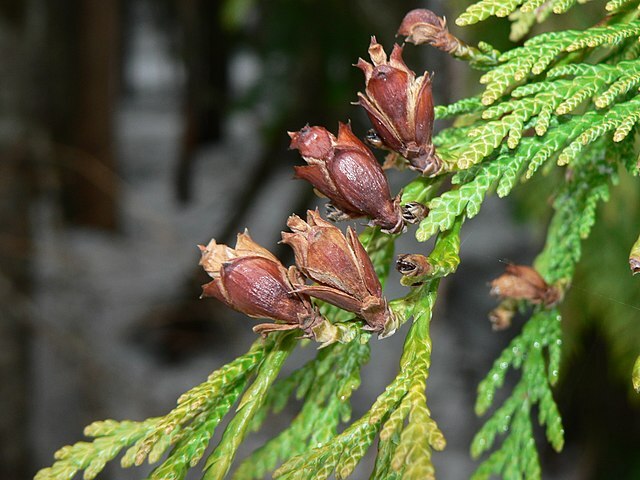
The cones of western red cedar are egg-shaped or slightly elongated, measuring 8 to 12 mm in length. Each cone has five to six pairs of thin, flexible scales.
Flowering Season
Cones develop at the tips of branches during late spring to mid-summer and mature by the end of summer to early fall.
Habitat
Western red cedar trees are native to the Pacific Northwest region of North America, growing in coastal regions along the western coast from southern Alaska to northern California.
They thrive in moist, temperate rainforests and can be found growing along streams, in valleys, and on the sides of hills and mountains.
These trees prefer well-drained soils and are often found growing near other evergreen species such as Douglas fir, hemlock, and spruce.
Western red cedars are also well adapted to the coastal climate, withstanding strong winds and salt spray from the ocean.
Some other understory plants that associate with western red cedar are:
- Salal (Gaultheria shallon)
- Sword fern (Polystichum munitum)
- Oregon grape (Mahonia aquifolium)
- Huckleberry (Vaccinium spp.)
- Thimbleberry (Rubus parviflorus)
- Wood sorrel (Oxalis oregana)
- False lily-of-the-valley (Maianthemum dilatatum)
- Evergreen blueberry (Vaccinium ovatum)
Wildlife Value
Western red cedar (Thuja plicata) provides important habitat and food resources for a variety of wildlife species.
For example, mammals such as squirrels and chipmunks eat the seeds.
Bears and cougars also frequently use the tree for shelter.
Additionally, the Western Red Cedar provides food, shelter, and nesting sites for birds such as:
- Pileated Woodpecker
- Northern Flicker
- Northern Pygmy Owl
- Swainson’s Thrush
- Olive-sided Flycatcher
- Hutton’s Vireo
- American Dipper
- Boreal Chickadee
- Varied Thrush
- Western Bluebird.
How to Propagate Western Red Cedar (Thuja plicata)

Hardiness Zone: 3-8

Soil Type: Clay, loam, sand.

Water: Normal

Exposure: Full Sun to Partial Shade.
You can propagate western red cedar with two effective methods:
- Stem Cuttings: It provides established trees faster, but is tricky, and will probably have a lower success rate.
- By Seed: The success rate is high but takes longer to get established saplings.
Cedar is one of the few conifers that propagate quite well by stem cuttings without too much trial and error.
Seeds are also fairly easy to gather.
All in all, both methods are particularly effective, so let’s take a look!
How to Propagate Western Red Cedar (Thuja plicata) by Seed
Propagating Western Red Cedar from seed is a straightforward process that can be done at home with a little patience and effort. Here are the steps to follow for a successful propagation.
How to Harvest Seeds
The best time to harvest Western Red Cedar seeds is in the late fall when the cones have matured and begun to shed their seeds. Look for cones that are brown and beginning to open, and gently shake them to collect the seeds.
Extracting the Seeds
To extract the seeds from the cones, gently crush the cones and separate the seeds from the debris. This can be done by hand or with the help of a seed-cleaning screen.
Stratification & Sowing
To help Western Red Cedar seeds germinate, they need to undergo a period of cold stratification.
Here’s how:
- Mix seeds with a moist medium (sand or peat moss) in a labeled plastic bag.
- Put the bag in the freezer for 21 days.
- Remove the bag and soak the seeds in warm water for 24 hours.
- Put the bag back in the refrigerator for another 7 days, making sure the medium stays moist.
- Plant the seeds in well-draining soil and water regularly until they sprout.
Note: You can still germinate western red cedar without cold-stratification, although the germination rate might be lower.
Western red cedar seeds germinate within a week after sowing.
How to Propagate Western Red Cedar (Thuja plicata) by Stem Cuttings
To propagate western red cedar through stem cuttings, follow these steps:
Pick the right time to take the cuttings, which is during the dormant period from late fall to early spring.
- Select young and vigorous trees as the source for your cuttings.
- Locate the current season’s growth and take the cuttings just below the transition from green to brown.
- Scuff the bark about 1 inch from the base, then dip it in rooting hormones (1,500ppm IBA).
- Plant the cuttings in a rooting medium like sand and peat mix (90/10) and maintain moisture levels.
- For accelerated results, you can use bottom heat and cover with plastic to retain moisture.
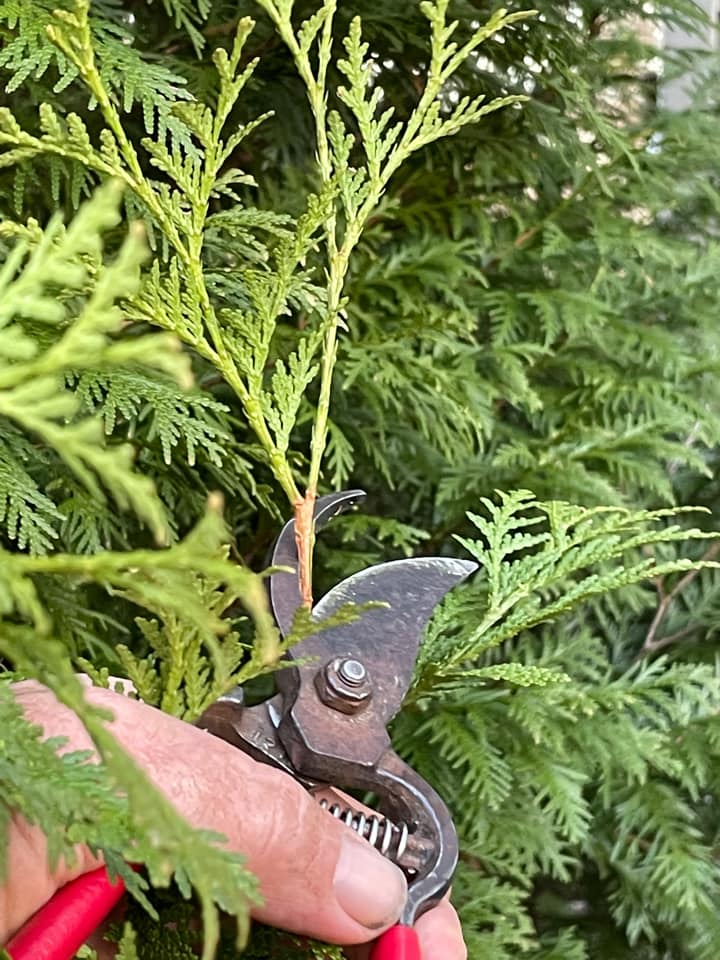
Roots may take up to 10-12 weeks to develop before repotting.
Western red cedar cuttings will first form a protective crust at the base, then roots will start to grow.
Avoid tugging at the cuttings as it may cause damage.
Patience is crucial and proper ventilation is essential to prevent rotting.
FAQ
Q: What is the best soil for western red cedar?
A: They tolerate a variety of soils but if you want to replicate their native soil, a good mix of sand, gravel, and peat will do the job.
Q: Can I grow cedar trees from cuttings?
A: Yes, semi-hardwood cuttings are a fast, and reliable method to propagate cedar.
Q: How do you start Western red cedar?
A: To start Western red cedar, you can either sow the seeds after cold stratification or propagate it through stem cuttings taken from young and healthy trees during the dormant period from late fall to early spring.
Q: What is the growth rate of a western red cedar?
A: Established western red cedars grow up to 2 feet per year in ideal conditions.
